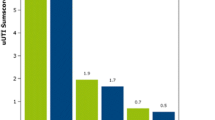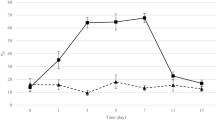Abstract
The influence of clindamycin, dicloxacillin, minocycline and norfloxacin on the faecal concentration of urobilinogen was investigated. The studied drugs were administered orally in standard dosage for six days to groups of six volunteers. A decrease in faecal concentration of urobilinogen following administration of clindamycin (P<0.01) and dicloxacillin (P<0.05) was found. The possible predictive value of a decrease of the faecal level of urobilinogen as an indicator for the impairment of microbial colonization resistance and for the risk of failure of oral anticonceptive treatment is discussed. It is suggested that clindamycin and dicloxacillin should not be combined with oral anticonceptive treatment unless more specific investigations have excluded interaction of these drugs with the oestrogen metabolism in the bowel.
Similar content being viewed by others
References
Clasener HAL, Vollaard EJ, Van Saene HKF. Long-term prophylaxis of infection by selective decontamination in leukopenia and in mechanical ventilation. Rev Infect Dis 1987;9:295–328.
Vollaard EJ, Clasener HAL, Van Griethuysen AJA, Janssen AJ, Sanders-Reymers AJ. Influence of amoxycillin, erythromycin and roxithromycin on colonization resistance and on appearance of secondary colonization in healthy volunteers. J Antimicrob Chemother 1987; 20(Suppl B):131–8.
Midvedt T. Effects of antimicrobial agents upon the functional part of the intestinal flora. Scand J Infect Dis 1986;(Suppl 49):85–8.
Saxerholt H, Midvedt T, Gustafsson BE. Deconjugation of bilirubin-conjugates and urobilin formation by conventionalized germ-free rats. Scand J Clin Lab Invest 1984;44:573–7.
Gorbach SL, Bartlett JG, Tally PF, ed. Intestinal flora and the cancer connection. In: Biology of anaerobes. Kalamazoo: Upjohn 1981:35–48.
Saxerholt H, Carlstedt-Duke B, Hoverstad T, et al. Influence of antibiotics on the faecal excretion of bile pigments in healthy subjects. Scand J Gastroenterol 1986; 21:991–6.
Heimdahl A, Nord CE. Effect of erythromycin and clindamycin on the indigenous human anaerobic flora and new colonization of the intestinal tract. Eur J Clin Microbiol 1982;1:38–48.
Vollaard EJ, Clasener HAL, Van Griethuysen AJA, et al. Influence of cefaclor, phenethicillin, co-trimoxazole and doxycycline on colonization resistance. J Antimicrob Chemother 1988;22:747–58.
Heimdahl A, Nord CE. Influence of doxycycline on the normal human flora and on colonization of the oral cavity and colon. Scand J Infect Dis 1983;15:293–302.
Adlercreutz H, Martin F, Tikkamer MJ, et al. Effect of ampicillin administration on the excretion of twelve oestrogens in pregnancy urine. Acta Endocrinol 1975;80: 551–7.
Author information
Authors and Affiliations
Rights and permissions
About this article
Cite this article
Vollaard, E.J., Jankowiak, M.M., Muller, N.F. et al. Faecal level of urobilinogen: an indication for the risk of superinfection and of failure of oral anticonception?. Pharmaceutisch Weekblad Scientific Edition 11, 165–168 (1989). https://doi.org/10.1007/BF01959465
Received:
Revised:
Accepted:
Issue Date:
DOI: https://doi.org/10.1007/BF01959465




